For about four years now, I’ve been putting out a series of articles taking a look at late-draft dart throws—players who aren’t your mid- or late-draft sleepers, but guys who are going super late in drafts, if at all.
All of the players featured in my article from March had an NFBC ADP of 250 or higher at the time the article was written, meaning these are guys who I believed were worth a late-round grab as they had potential to be useful for your team and could easily be dropped if things didn’t pan out without seriously hurting your team.
For the past couple of years, I’ve decided to take a look back at how those dart throws panned out, so we’re here to do it again! Let’s dive in!
Final season stats: .238/.238/.286, 2 RBI in 6 games
I was really rooting for an Austin Meadows bounceback season this year, but sadly it wasn’t to be.
Meadows missed all of 2022 with a variety of problems, including tendinitis in his Achilles, vertigo, and COVID-19. In the offseason, Meadows talked a good bit about how he was ready for a fresh start after a pretty rough 2022, but after just six games, Meadows was placed on the IL due to anxiety and never came back.
Honestly, given what Meadows is going through, it seems silly to whine about him being a fantasy disappointment, because Meadows stepping away from baseball to manage his mental health is so much more important. And I give him a lot of credit for having the courage to not only know he needed to step away but to be public about it too.
And I give the Tigers a lot of credit too. They’ve been handling the situation about as well as they possibly could, giving Meadows the privacy and space he needs to manage things. I really hope we get to see him play in the Majors again soon.
Final season stats: 25.2 IP, 3.16 ERA, 1.05 WHIP, 27.5% strikeout rate, 4.9% walk rate
Drafting Tyler Mahle was looking like it was going to pay off big time early in the season. Through his first five starts, he posted a 3.16 ERA with a 3.12 xERA, and was striking guys out at a high clip while limiting walks better than he has to this point in his career. He looked good.
And then Mahle was pulled early from his April 26 start against the Royals with elbow soreness. Initially, the injury was thought to just be inflammation, but in early May we learned it was more serious than that, and that Mahle would be having Tommy John surgery.
Unfortunately, that means at best we’re looking at Mahle maybe returning for the All-Star break next year. And given how recovering from Tommy John can go, it could be later than that. John Means was supposed to come back from Tommy John during the All-Star break this past season and didn’t actually end up coming back til September.
Mahle’s a free agent after this year, so I think we can officially say that trading away Spencer Steer and Christian Encarnacion-Strand for nine starts of Mahle hasn’t exactly worked out great for the Twins.
Final season stats: .268/.315/468, 28 HR, 101 R, 86 RBI, 20 SB
Now, I have to say, I think this one worked out pretty well.
I had Lane Thomas as a dart throw going into the 2022 season, just because I liked his power/speed combo and the fact the Nationals were likely to lead him off pretty often.
That didn’t work out super great as he turned in a pretty pedestrian .241/.301/.404 season with 17 home runs and eight steals, but I was hopeful coming into 2023 because Thomas had seemed to figure things out in the latter half of 2022.
While his first-half and second-half slashlines in 2022 weren’t totally night and day from each other, PLV told us a different story:

It looked like Thomas got less aggressive at the plate and had better judgment of the strike zone, which led to better performance.
Now, Thomas wasn’t consistent with his plate discipline all year. His strikeout rate rose from 24.1% to 25.8% and his walk rate dropped from 7.5% to 5.3%. And you can see his PLV decision value was all over the place during the season:
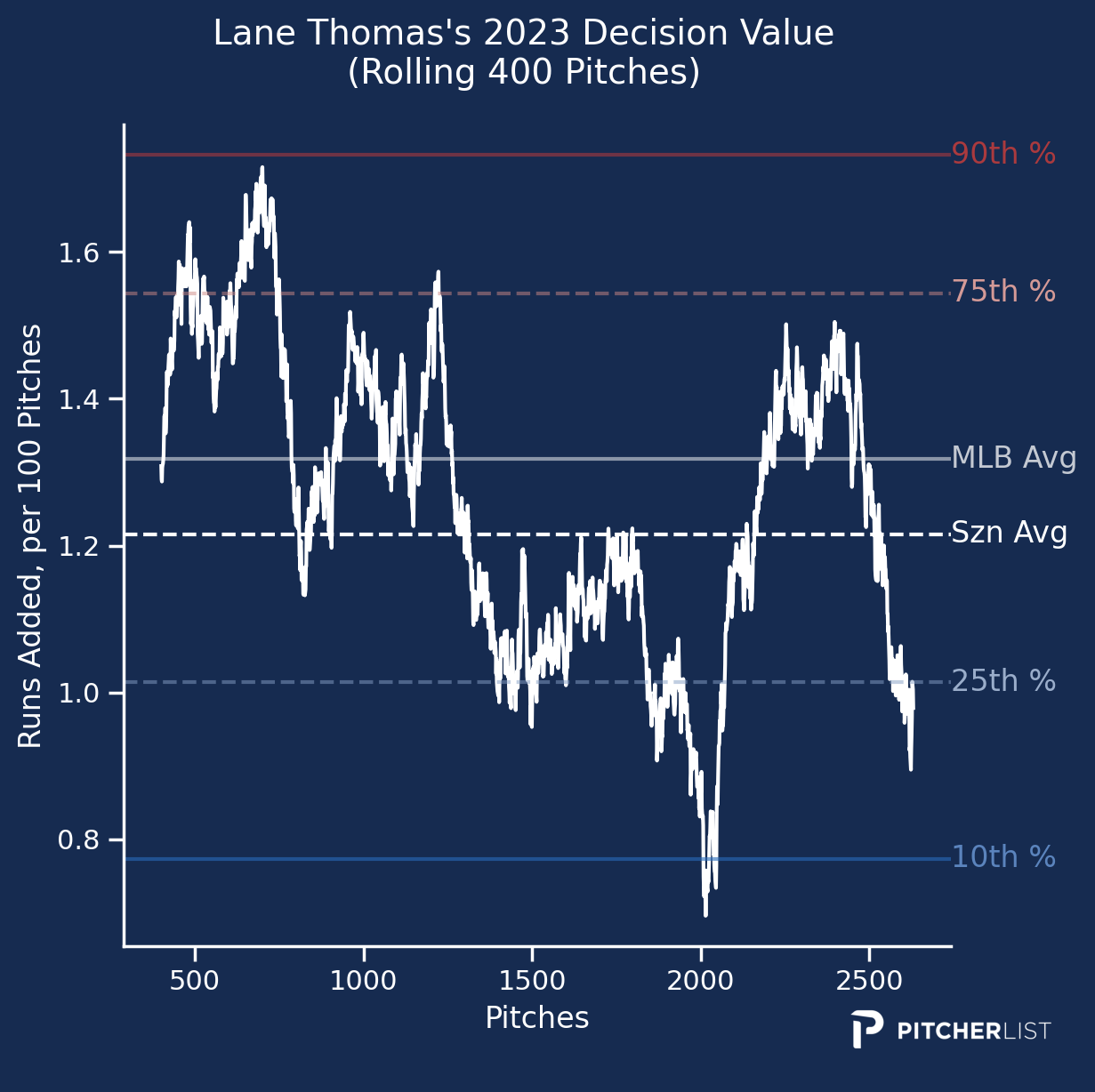
He was a bit streaky at times, no doubt, but Thomas showed great ability to not only steal bases but hit for power too:
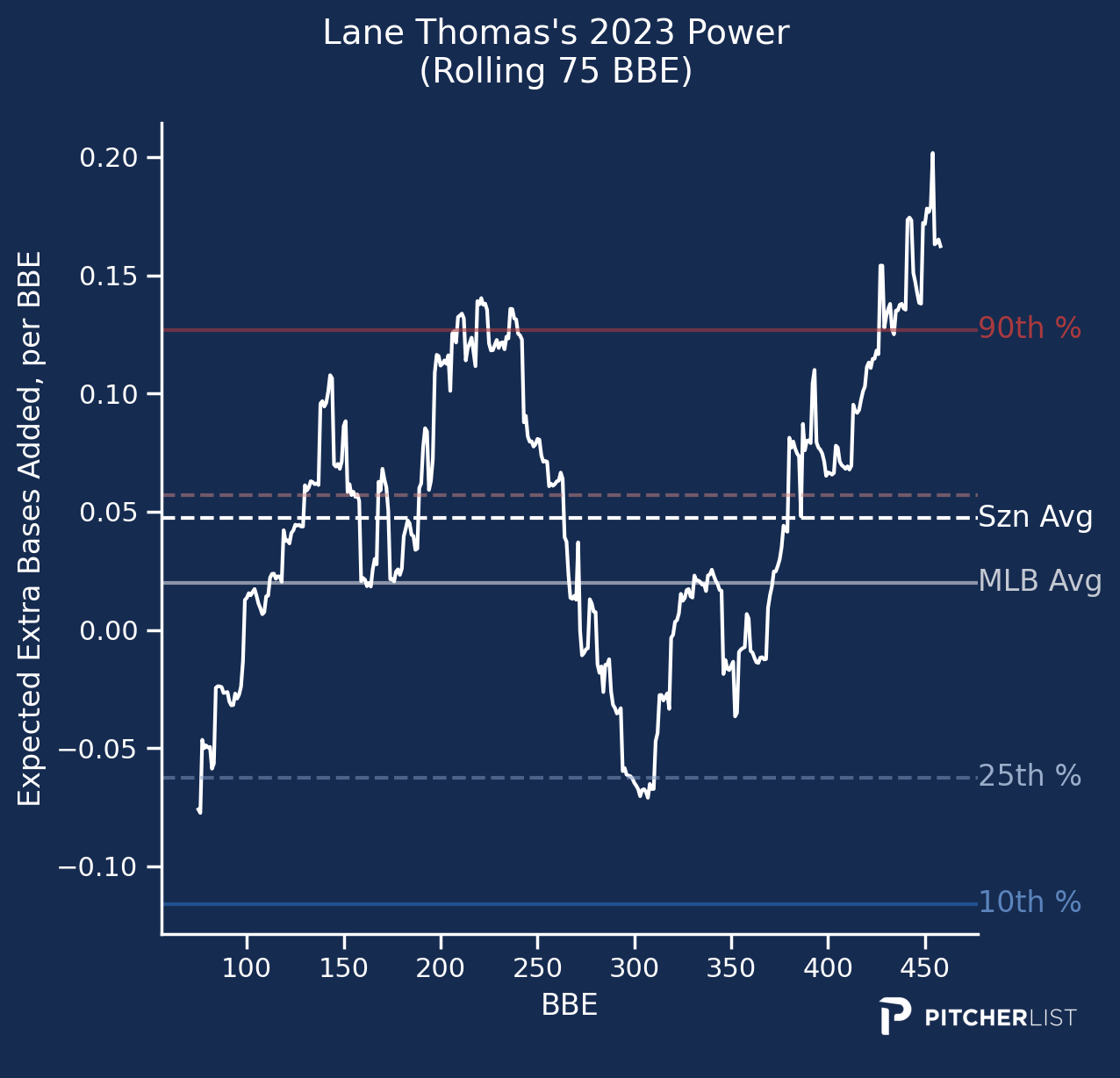
Given Thomas was generally going later than the 25th round in most drafts, I’d say getting a guy who hit nearly 30 home runs and stole 20 bases worked out pretty well. Here’s hoping Thomas can do even better next year.
Final season stats: .253/.327/.419, 11 HR, 44 R, 49 RBI, 13 SB
I wanted to believe man, I really did. I was hoping this was the year for Jarred Kelenic, maybe this was the year for a post-hype prospect to really break out.
One of the things I mentioned in the original article was that Kelenic has always had the power ability, he just couldn’t make contact at the plate. But what was encouraging to me was all the talk during the offseason of Kelenic working with different hitting coaches and adjusting his swing.
Kelenic seemed very aware of his problems and was working to address them. So how did that contact ability work out in 2023?
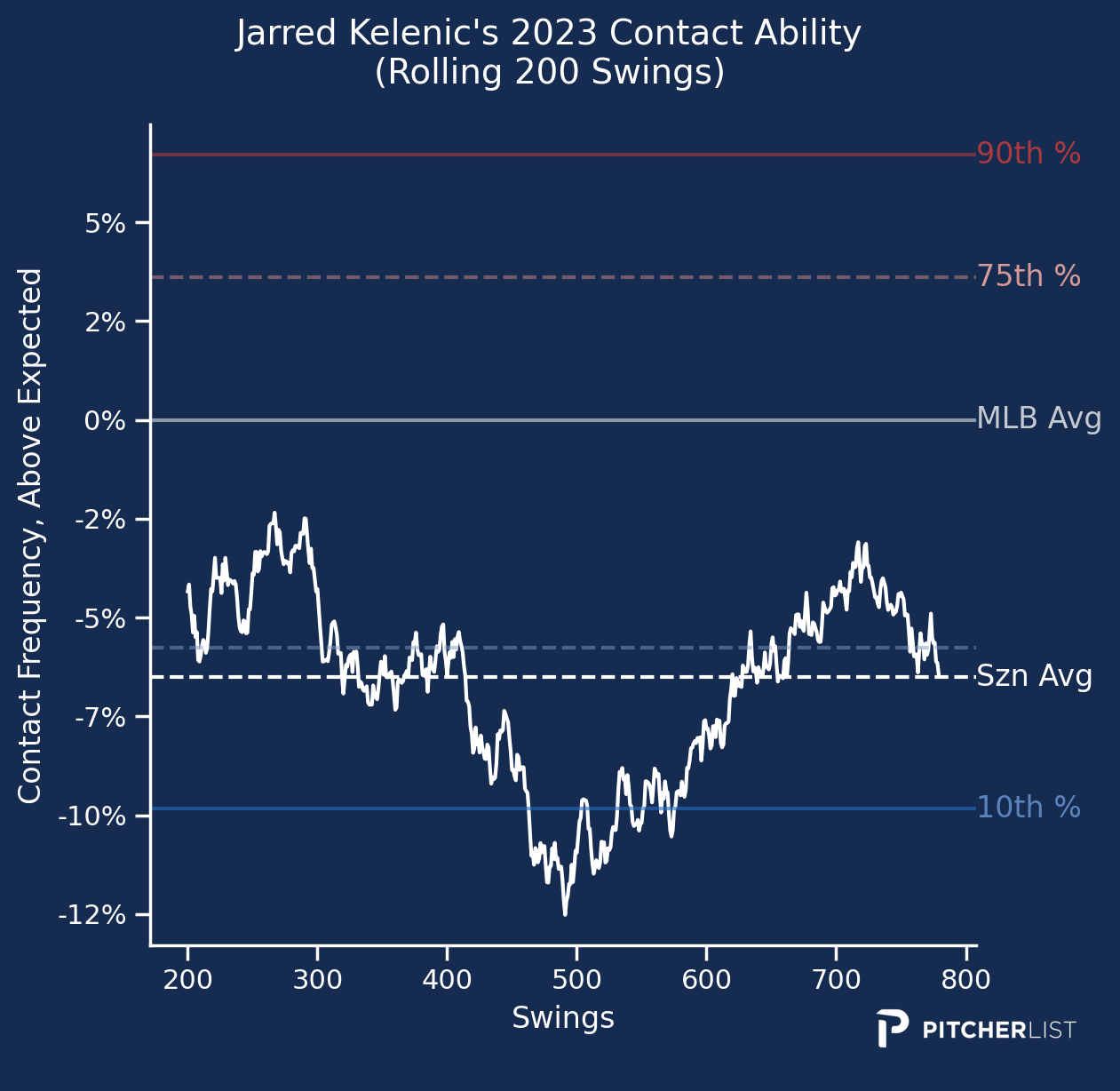
Not great! Kelenic still couldn’t make consistent contact, and it really hurt him.
I really hope Kelenic is eventually able to put things together and be a consistent contributor for the Mariners, he’s still only 24 so there’s at least a little bit of time left, but the clock is running out on Kelenic before he’s considered a total bust.
Final season stats: 89.0 IP, 5.36 ERA, 1.35 WHIP, 18.4% strikeout rate, 4.2% walk rate
Yeah, so this one didn’t work out at all.
I was pretty bullish on Ross Stripling coming into this season, mainly because his 2022 was really good, with a 3.01 ERA, 3.11 FIP, and 3.57 xERA through 134.1 innings, as a result of changes to his pitch mix he made—cutting down how much he threw his mediocre fastball and cutting down his curveball usage and instead increasing how much he threw his changeup, which was the best changeup in all of baseball in 2022 by PLV.
So what happened? Well, diving into Ross Stripling’s 2023 is pretty interesting. He pitched in 22 games but only started in 11, spending most of the year in the bullpen after some pretty rough starts to begin the year.
And it looks like he tweaked his repertoire again. Here’s 2022 and 2023 side by side, with each pitch’s corresponding PLV:
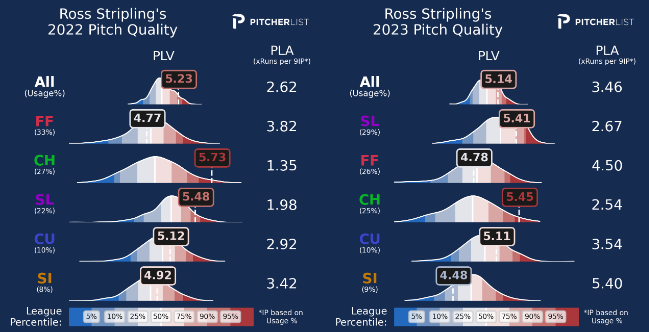
Stripling brought down his fastball usage even more but also brought down his changeup usage a bit, and started using his slider as his primary pitch.
I want to caveat here and say, it’s hard to know how much of this change was Stripling making some tweaks to just be a better pitcher and how much was changing things because he was coming out of the bullpen rather than pitching as a starter.
That said, taking a look at the results, it seems like hitters figured out Stripling’s changeup a bit. He started locating it differently, throwing it more gloveside than he did in the past, but otherwise it was essentially the same pitch as in 2022. Only this time, opposing hitters had a .344 wOBA against it compared to a .233 wOBA the year before.
There was a little bit of bad luck in play, as opposing hitters had a .325 xwOBA against the pitch, but the changeup just wasn’t the dominant pitch it was in 2022. The chase rate dropped from a stellar 49.6% to 37.1% (which is still pretty good), and the CSW dropped from 27.7% to 23.1%.
The changeup seemed to be the main issue, as the rest of his repertoire was fairly solid. It’s odd to see, given how good the changeup was last year, but even still, based on his repertoire alone, you’d think Stripling would’ve been better than he was. Sadly, things didn’t work out.
Final season stats: 117.2 IP, 4.44 ERA, 1.24 WHIP, 25.7% strikeout rate, 8.4% walk rate
My inclusion of Manaea on this list was similar to my inclusion of Kelenic in some ways—taking a shot on a guy who seemed to have made some adjustments in the offseason.
Manaea’s generally been an alright pitcher, and from a PLV perspective, his 2022 was just that—nothing bad, but nothing especially good. But coming into this season, Manaea’s sinker seemed to increase velocity (thanks to a visit to Driveline) and Manaea praised the information he was getting from the Giants.
All of that was interesting enough for me to take a shot on Manaea. Unfortunately, Manaea didn’t do much this year. Yes, the sinker velocity did stick, averaging 93.6 MPH compared to 91.2 in 2022, and it does look like Manaea toyed with his repertoire some, significantly increasing his slider use while dropping his sinker and changeup use.
But ultimately, it didn’t work all that well. I will say, none of Manaea’s pitches had a wOBA against worse than .320 (that was his slider), which is pretty solid. But when hitters did make contact, they hit the ball pretty well, with a .188 ISO against his slider and a .161 ISO against his sinker.
All in all, Manaea was a decent real-life pitcher and not particularly useful as a fantasy pitcher.
Final season stats: 104.1 IP, 4.23 ERA, 1.17 WHIP, 27.3% strikeout rate, 6.5% walk rate
From a fantasy perspective, Kenta Maeda is kind of an interesting case. On its face, his final statline doesn’t look super great—a 4.23 ERA doesn’t help you a ton (though the 27.2% strikeout rate does) and he only started 20 games thanks to some injuries.
But those numbers don’t really tell the whole story. From June 26 on (which was his first game after his IL stint), Maeda posted a 3.36 ERA with a 3.94 FIP and a 29% strikeout rate. In fact, only once from June 26 on did Maeda give up more than three earned runs in a start, and out of those 16 starts, he only gave up three earned runs four times.
Mixed in there were some pretty awesome starts, like his July 4 game against the Royals where he posted a 7.0 IP, 1 ER, 9 K line.
I don’t know if Maeda was pitching hurt to start the year or what, but he was a totally different pitcher once he came back from injury, and he was absolutely a value add to your fantasy team if you were able to snag him.
Maeda’s a free agent now, so it’ll be interesting to see what kind of situation he finds himself in. If he can land somewhere in a consistent starting role, he’s still going to have plenty of fantasy value—you just have to bake in an IL stint at some point (though, hopefully not).
Final season stats: .191/.267/.272, 2 HR, 15 R, 14 RBI, 4 SB
The idea behind putting Oswald Peraza on this list was fairly simple. It’s never a bad idea to take a shot on a young, talented hitter who’s going to have an opportunity in a good lineup.
Well, basically everything in that sentence turned out to not be true. Peraza didn’t get a consistent opportunity (only 52 games), didn’t play well at all when he was given an opportunity, and the Yankees lineup ended up not being a good lineup (seventh-worst team wOBA in all of baseball).
I still think Peraza has plenty of fantasy potential in the future. He’s shown a speed/power combo in the minors that’s really enticing. In 63 games in Triple-A last year, he went .268/.357/.479 with 14 home runs and 16 stolen bases.
But Triple-A numbers don’t mean all that much if you can’t translate them to the Majors, and last year, Peraza couldn’t. But like I said, he’s still young, and there’s plenty of time for him to contribute as a fantasy asset. It wouldn’t shock me if he’s all over sleeper lists again this year.
Final season stats: 141.0 IP, 5.36 ERA, 1.56 WHIP, 20.7% strikeout rate, 11.1% walk rate
Coming into this season, Ken Waldichuk was one of those guys whose stuff impressed me more than the results had. He only pitched seven starts in 2022 and turned in a pretty rough 4.93 ERA to go with it. But, looking at the numbers on his repertoire from a PLV perspective, he looked interesting:
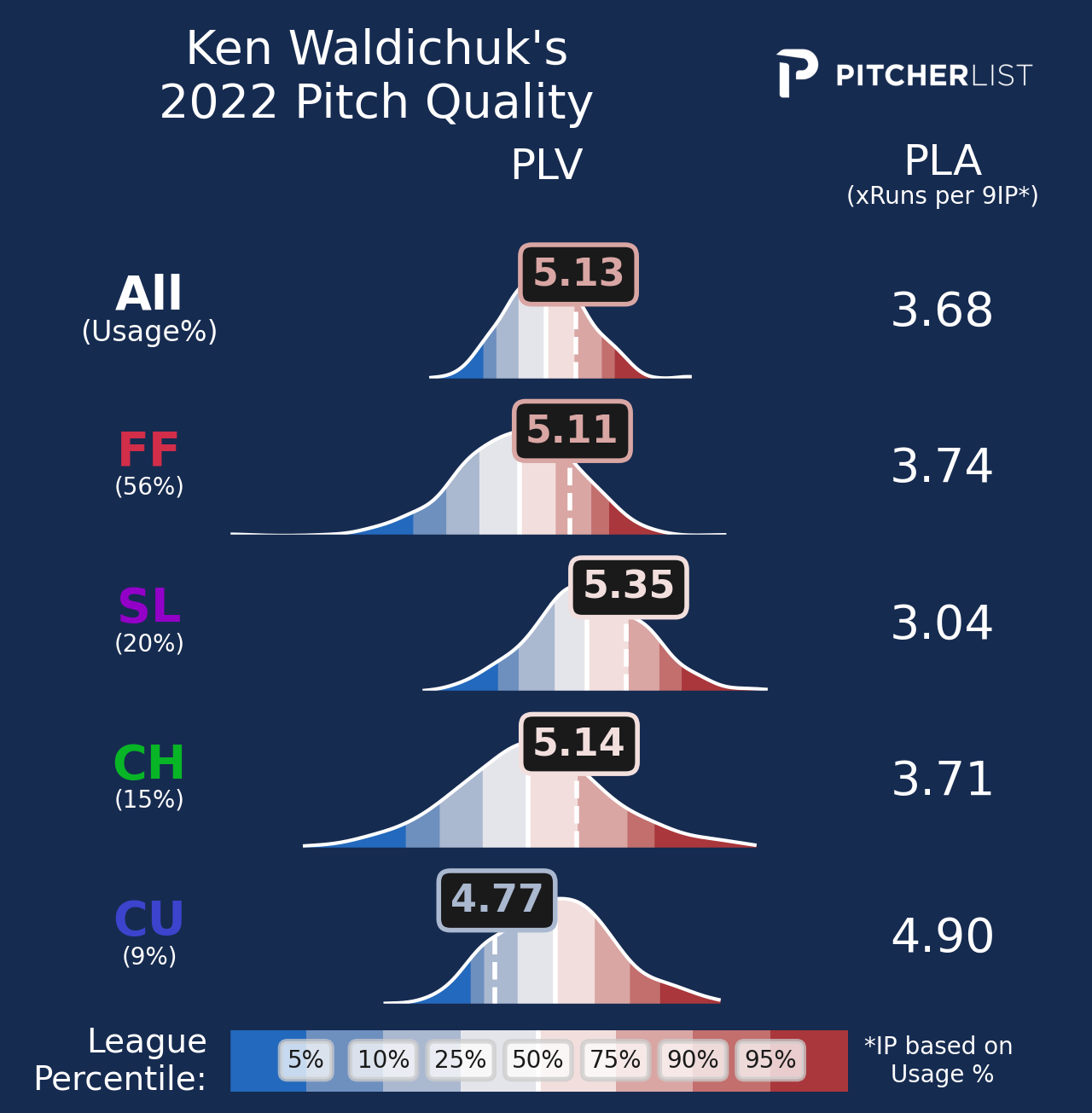
Outside of his curveball, which was his least-thrown pitch, there wasn’t a single bad pitch there. Of course, that was a small sample size and everything, but here’s how the repertoire turned out this year:
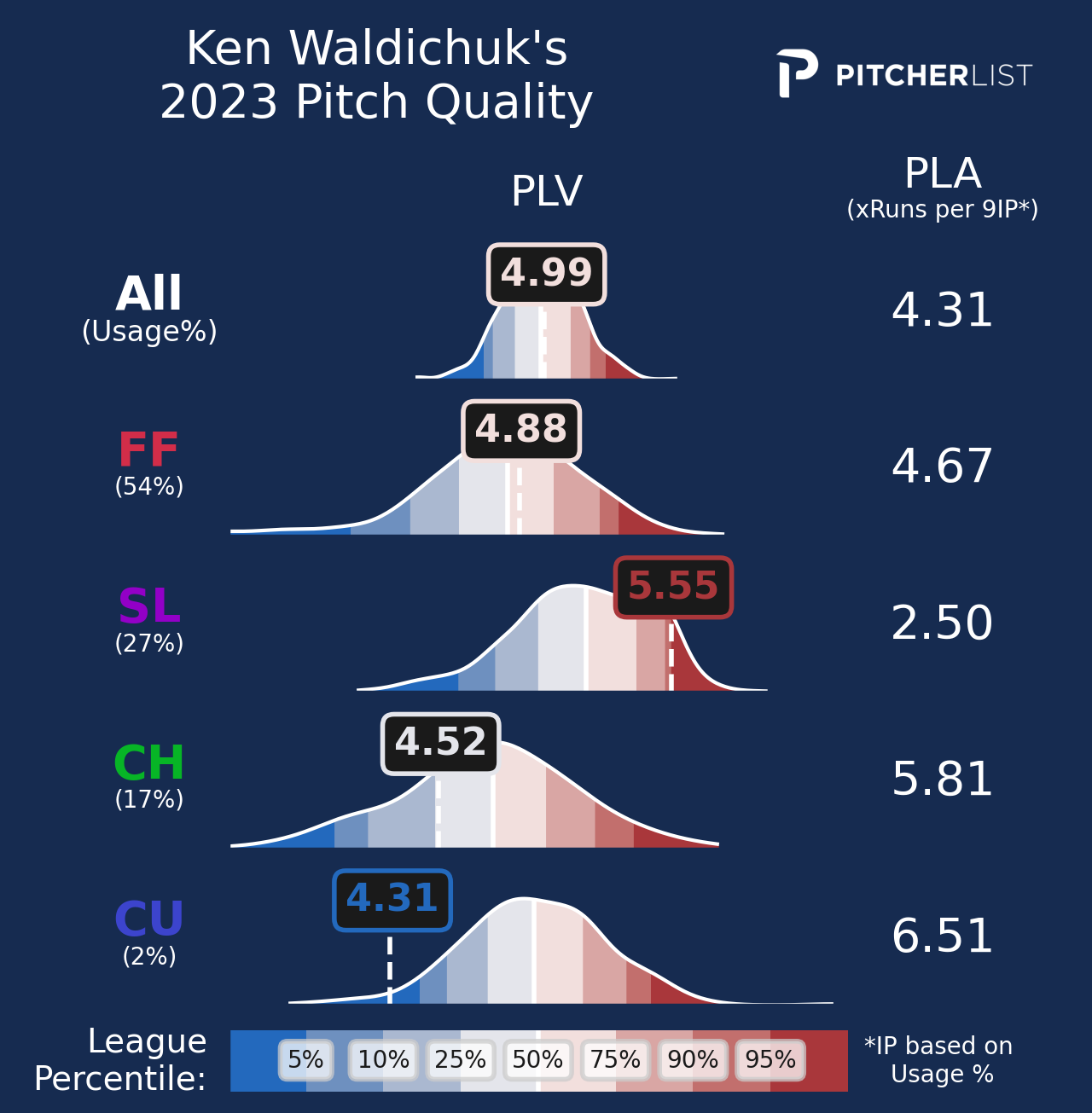
The fastball was decent enough, the slider was good, but the changeup struggled.
Waldichuk’s fastball wasn’t incredible as opposing hitters had a .275 AVG and .380 wOBA against it, but the slider was solid, posting a 30.8% chase rate, 15.1% swinging-strike rate, and a 31.9% CSW.
But that changeup was rough. It did post a 36.8% chase rate, which is awesome, but it also came with a .340 AVG against and a .372 wOBA against.
Now, there’s an argument to be made that there was some bad luck at play with Waldichuk. Remember how the fastball had a .275 AVG and .380 wOBA against? It also came with a .241 xAVG and .355 xwOBA against. Same deal with the changeup—the .340 AVG and .372 wOBA against came with a .262 xAVG and .308 xwOBA against.
Basically, all of this is to say, I do still think there’s some potential for Waldichuk, and towards the end of the year, he tweaked his changeup and improved it. There’s a lot of interesting stuff here with him, but there’s also a whole lot he needs to put together before he’s viable as a fantasy asset, so just keep an eye on him.
Final season stats: 31.0 IP, 7.26 ERA, 1.68 WHIP, 16.6% strikeout rate, 10.3% WHIP
Welp, it’s always a sad day when you have to let go of a player you’ve loved for a long time, but I think that’s the case with Spencer Turnbull now.
Turnbull had Tommy John surgery and before his first start of 2023, he hadn’t pitched since 2021, and in 2021, he looked really good. So naturally, with Turnbull coming back in 2023, I was pretty hyped that he could return to some version of his former self.
Unfortunately, that didn’t happen, and Turnbull was ultimately demoted to Triple-A after just seven starts.
So what went wrong? Basically everything, but the main issue was his slider. In 2021, Turnbull’s slider was his best pitch, posting a 35.4% chase rate, 18.4% swinging-strike rate, 36.8% CSW, and a .255 wOBA against. And that’s generally been the case with his slider.
But this year, Turnbull just didn’t have it with the pitch. Every stat on it got worse—the chase rate was 31.5%, the swinging-strike rate was 12.1%, the CSW was 26.6%, and hitters had a .290 AVG and .360 wOBA against the pitch (though, worth noting, a .187 xAVG and .263 xwOBA).
Turnbull was locating the pitch a lot differently, throwing it arm-side a lot more than he did before and it just wasn’t working. If Turnbull can find his slider again next season, I’ll be intrigued, but he’s going to have to earn a spot in a Tigers rotation that’s starting to get a little crowded.
Final season stats: 144.0 IP, 5.31 ERA, 1.42 WHIP, 15.5% strikeout rate, 7.4% walk rate
Ryne Nelson only had three starts in 2022, but he looked pretty good in that limited action, making him worth a flier for this season once he made the rotation.
Unfortunately, that didn’t turn out particularly well, and the main reason for that is Nelson’s lack of a secondary pitch.
Nelson’s fastball is awesome, but it’s basically his only pitch. He throws the fastball around 55% of the time and occasionally mixes in a cutter and slider that are decent as well. But his main pitch, the main thing about Ryne Nelson, is that fastball.
Which is great, I love that he has that fastball to work off of as a foundation. If he can find a wipeout slider or if the cutter can really take a step forward and he can develop a secondary pitch or two that work as swing-and-miss pitches, then I’m going to be really interested in Nelson’s potential going forward. And maybe that happens this year—keep an eye on him and see if he starts making changes to his repertoire. If something develops, Nelson could be a really interesting pitcher.
Final season stats: 103.2 IP, 4.43 ERA, 1.54 WHIP, 22.4% strikeout rate, 9.3% walk rate
If you want to talk about a dart throw, Paul Blackburn was very much a dart throw. Blackburn had one of the best cutters in the league in 2022, despite turning in a pretty unexciting season otherwise. Along with that cutter was a pretty solid curveball but basically nothing else. And worse, his most-thrown pitch was his sinker, which was very bad.
But there were reports during the offseason that Blackburn was tinkering with his repertoire, which was really interesting to me. I had hoped perhaps he saw the sinker was really bad, the cutter/curveball combo was solid, and maybe he’d make some changes.
Unfortunately, he didn’t really.
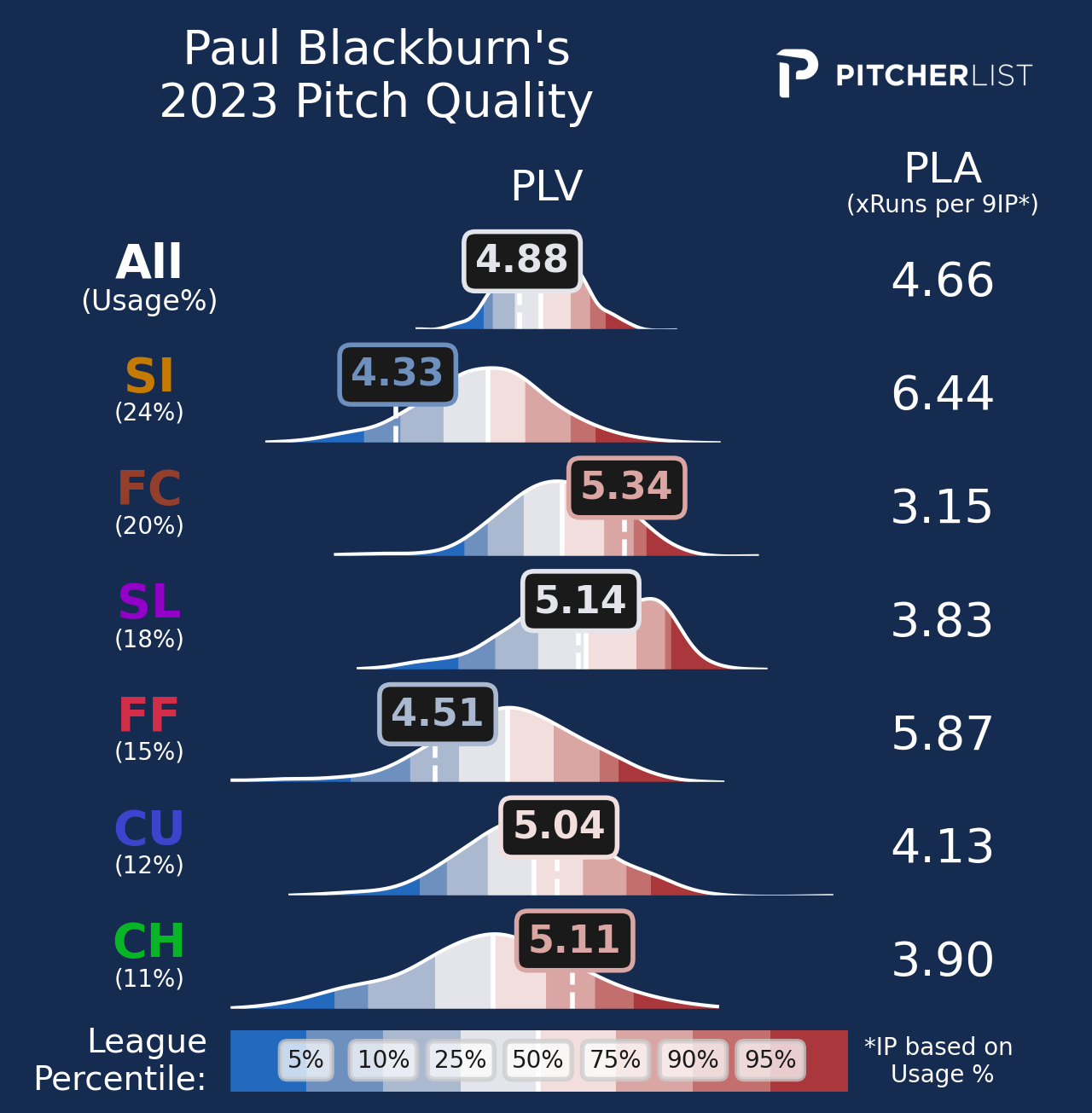
Don’t get me wrong, the cutter was still great, and the numbers the curveball posted were solid, but he barely threw the latter pitch and he continued to throw his sinker which hitters had a .369 wOBA against.
Blackburn also missed some time at the start of the year, but all in all, the hope I had for Blackburn didn’t really pan out, and unless he makes some significant changes coming into next year, I don’t think he’s going to be a guy to target in your fantasy league.

